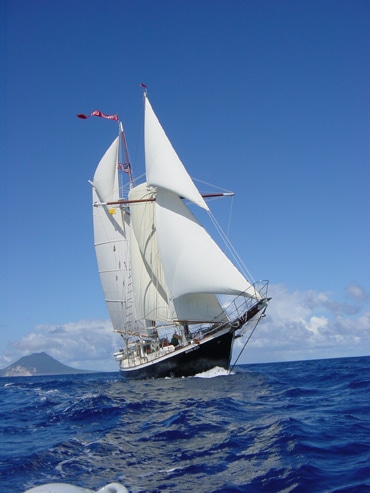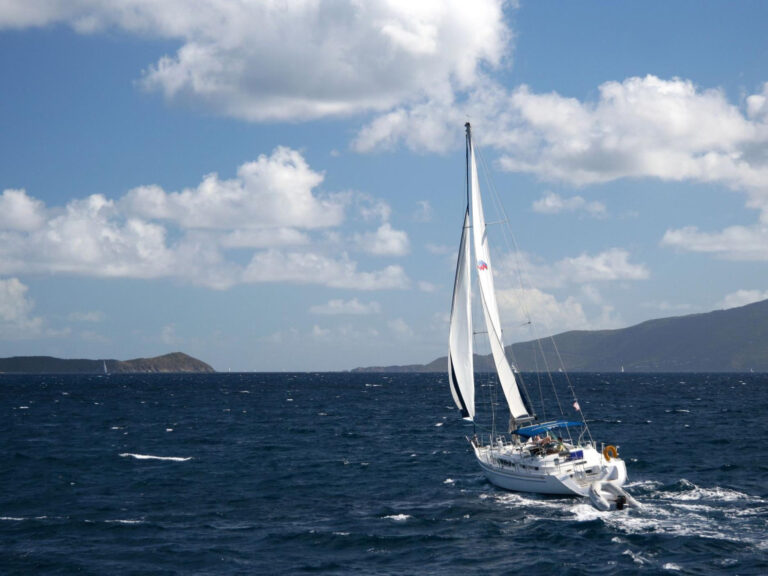
Earl MacKenzie
Several hundred miles north of Puerto Rico, we were sailing along at a leisurely six knots under a clear blue sky when the line on the starboard fishing reel began screaming. Tim yelled “Fish on!” and grabbed the rod while Bonnie, my wife, turned the autopilot off and eased Bonnie Lynn up into the wind to slow her down. Captain Tim Flaherty owns and operates a charter fishing business in Newport, Rhode Island, and frequently crews for us on offshore passages. His passion is fishing, and when he’s aboard, Bonnie Lynn always trails several lines.
I quickly put the fighting belt around Tim’s waist. He put the base of the pole into the socket and began reeling in the fish. Tim brought the good-sized tuna close to the transom, where I stood by with the gaff. As Tim pulled it near the hull and I leaned over with the gaff, a great dark shape shot out from under the boat and swallowed our tuna. In one fluid motion, the great fish leaped skyward just aft of our stern, nearly impaling the dinghy nested on the davits. When the fish went back down, the resulting splash soaked both of us. We later estimated the giant blue marlin to have weighed at least 1,500 pounds. We suspected that it’d been swimming leisurely in the shade under our boat when it caught sight of an easy dinner and pounced.
Fishing on offshore passages nearly always offers some excitement and surprises. We’ve caught tuna, wahoo, kingfish, barracuda, sailfish, and dorado, which is also known as mahimahi or dolphinfish. Fishing under sail offers unique challenges, primarily in the area of boat-speed control. We generally sail between five and eight knots, an ideal trolling speed. The challenge comes after hooking a fish. Powerboats make it possible to quickly vary your speed and maneuver in any direction, depending on sea conditions. Options are more limited under sail. We usually head up, sheet the sails in tight, and pinch so we’ll slow down; we want just enough speed to maintain steerage. This makes reeling in the fish, especially a large one, much easier. If the seas are such that heading up is an uncomfortable option, we ease the sheets and reduce sail. As we pull the fish closer, we take care to keep it from making a run under the boat and fouling the line around the prop or rudder. We keep two sharp gaffs on hand. With practice, a fish can be gaffed and swung aboard in one fluid motion, which is ideal.
As soon as the fish is aboard, we pour strong rum of the cheap variety into the gills. I feel that this, rather than clubbing, is a far more humane and civilized way to dispatch the fish. A few brief shudders, and it’s all over. I joke that this process gives us a jump start on the marinating. The fish is then bled, filleted, vacuum sealed, and frozen. Occasionally, fresh sushi is the order of the day. The walls (sides) of the Gulf Stream are prime fishing grounds. When sea conditions permit, this area often helps to fill the freezer with an ultra-fresh catch.
Bait shops at sea are obviously few and far between, so we often use a variety of lures. We do get occasional fresh bait in the form of flying fish. These four- to 10-inch-long offshore fish live near the surface, where they’re the favorite meal of the lightning-fast dorado. Their airborne antics are their only hope of escape, plus they always look like they’re having a good time flying along. Unfortunately for them, they often end up on deck during the hours of darkness. Bonnie had one hit her in the head in the dead of night. I’ve been hit twice. On a calm night on an offshore passage, some sailing friends of ours had a flying fish thread the needle through an open porthole and land on the pillow beside the head of a sleeping crewmember. He awoke screaming to a fish slapping him again and again in the face.
The folks living around Admiralty Bay, off the Caribbean island of Bequia, are familiar with the early morning conch horns announcing that the fishermen are in with the morning catch. These fishermen head out at first light in small boats to fish the channel between St. Vincent and Bequia for the tuna that feed there. The arrival of a school near the surface is announced by the various birds diving to get the scraps from the carnage wreaked by the feeding tuna. The fishermen troll around the edges of the school trying not to spook the tuna into diving.
We heard the story of a local, nicknamed Fisher, who hooked up with a marlin while trolling by hand in his underpowered 14-foot boat. The scene was right out of Hemingway’s Old Man and the Sea. He fought the fish for half a day. First it dragged him toward St. Vincent, then back to Bequia and toward Canouan. The fish finally called it quits, and a passing boat towed Fisher and his catch back to Bequia. The marlin weighed nearly 300 pounds—to Fisher’s 120.
We prefer to catch fish that weigh less than 40 pounds. Fish larger than this make it difficult to boat them, subdue them, and clean them. You can usually limit the size of the fish you catch by using smaller lures, but occasionally things go awry. Often, a smaller fish being pulled in becomes the target of a much larger fish. Several times when bringing in a fish we’ve suddenly felt a violent jerk, then no more fight. Often the only thing left is the head, cleanly severed just behind the gills. Occasionally the larger fish gets hooked up, and then a long fight ensues. We once brought in a beautiful sailfish. Fortunately, we were able to maneuver it alongside and remove the hook so the fish got the chance to fight another day.
Our least favorite fish to catch is the notorious barracuda. Their long, jagged teeth make them difficult to get off the line. They continually snap at anything within reach. Barracuda are eaten throughout the Windward Islands, but on the northern rim of the eastern Caribbean, they commonly carry ciguatera, a dangerous toxin that affects the central nervous systems in humans. We also find them to be rather bony and difficult to fillet. The average barracuda we catch measures two feet in length, but occasionally they reach five feet.
Sometimes fishing pays off in unexpected ways. Several years ago, I entered Bonnie’s name in a rather large chowder competition at the Spring Charter Yacht show in Newport, Rhode Island. She was less than pleased with me when she learned of my surreptitious actions only on the day before the show. It all worked out in the end, however: Bonnie won first place using a variety of wahoo, mahimahi, and kingfish from our trip north that year. But I know that if I ever pull a stunt like that again, I’ll pay dearly.
Earl MacKenzie and his wife, Bonnie, live aboard the schooner Bonnie Lynn (www.bonnielynn.com) and spend their summers chartering and operating a Seamanship program out of their home port of Islesboro, Maine.




